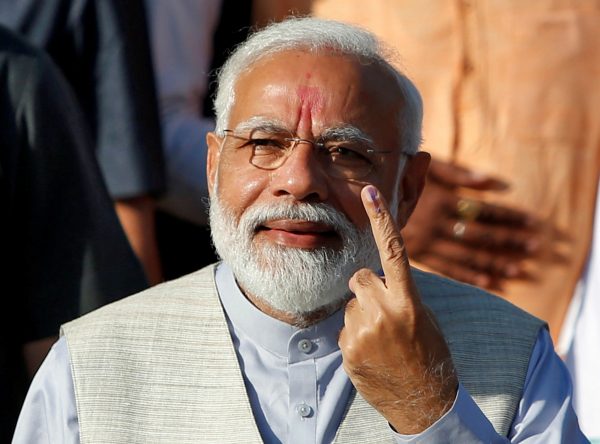But after five years of failed economic experiments and rising sectarian tensions, it could win instead on a campaign based more on fear than hope.
India’s ongoing 17th general election has been described as a ‘turning point’ for the country’s democratic institutions, political economy, national identity and the integrity of the country itself. Halfway through the complex, seven-stage election, the outcome remains uncertain. While a year ago the Modi government’s days seemed numbered after the BJP lost several crucial states to the INC, today the most likely outcome is a hung parliament with a BJP plurality. But quite different outcomes are still possible. There are several reasons for the uncertainty.
While Indian national elections are primarily referendums on the central government, opinions about state governments can have a significant effect as well. A pre-election opinion survey by the venerable Centre for the Study of Developing Societies shows that while approval of the Modi government has rebounded over the past year, public approval of state governments in many states ruled by parties opposed to the BJP is higher than that of the national government.
There is also the interplay of caste competition and party politics. Over the past century many traditionally lower and middle-status castes have combined for political purposes into larger castes or even into official meta-castes like the Scheduled Castes (SCs) and Other Backward Classes (OBCs). In recent years the BJP has exploited competition over access to preferential quotas for SCs and OBCs by courting less-privileged groups within each grouping and castes wishing to be counted as OBC. Many electoral analyses, therefore, turn on guesses about how different caste communities will vote.
Overlapping with the caste competition are the alliance calculations of various regional parties, many based on caste identity. Early in 2019, there was talk of a Grand Alliance (Mahagathbandhan) of all parties opposed to the BJP. But by the time the elections began, few significant regional parties were willing to ally with the INC — robbing the grand alliance of a unifying glue. The reasons are not hard to identify.
In a first-past-the-post electoral system, electoral alliances require parties to agree to forego competing in some seats and support their allies’ candidates. But there is always uncertainty as to which parties are strong in a seat and whether one party’s votes will transfer to another.
The INC’s history as India’s dominant party for many decades further complicates the situation. Most regional parties emerged as challengers to the INC. In turn, INC leaders are always hoping to revive the former glory that its would-be regional allies are afraid of. The INC’s 2018 victory over the BJP in three crucial North Indian states has only heightened this uncertainty by signalling the party’s revival.
India’s largest state, Uttar Pradesh (UP), perfectly illustrates these intersecting factors. With 81 seats, UP has just over one in seven national parliamentary seats. In 2014, with 42 per cent of the state vote, the BJP won 71 seats in UP because the non-BJP vote was split among three caste-based regional parties. UP therefore accounted for over a quarter of the BJP’s total tally of 282 seats. This year, however, the three regional UP parties have united.
Even if the BJP suffers no loss in its vote share, if these three regional parties successfully transfer their votes to each other in seats they are not themselves competing, this would reduce the BJP to about 30 seats. But if some voters of each party are unwilling to vote for its allies, the alliance effect substantially drops off. This partly accounts for the BJP state government’s efforts to manipulate eligibility for affirmative action programs in a way that would exacerbate conflicts within and among these parties.
The good news for the BJP is that the Modi government is more popular than any one alternative and the opposition has not coalesced into a single alliance. The bad news is that voters do not rate the BJP’s performance very highly. In several large core BJP states in North India that went to the INC in 2018, the new state governments remain popular, and the heavy reliance of the BJP on North Indian states for its parliamentary majority makes it vulnerable to a situation where it retains its vote share plurality but suffers tremendous losses in seats. While the BJP’s electoral outcome is unclear, what is clear is the decisive role coalition formation or fragmentation might play in this and future elections.
Arun Swamy is Associate Professor of Political Science at the University of Guam.

